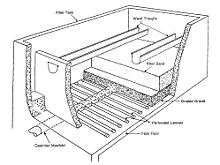Rapid sand filter

The rapid sand filter or rapid gravity filter is a type of filter used in water purification and is commonly used in municipal drinking water facilities as part of a multiple-stage treatment system.[1]
The first modern rapid sand filtration plant was designed and built by George W. Fuller in Little Falls, New Jersey. Fuller's filtration plant went into operation in 1920[2] and its success was responsible for the change to this technology in the U.S.[3] Rapid sand filters were widely used in large municipal water systems by the 1920s, because they required smaller land areas compared to slow sand filters.
Design and operation
Rapid sand filters use relatively coarse sand and other granular media to remove particles and impurities that have been trapped in a floc through the use of flocculation chemicals—typically alum. The unfiltered water flows through the filter medium under gravity or under pumped pressure and the floc material is trapped in the sand matrix.
Mixing, flocculation and sedimentation processes are typical treatment stages that precede filtration. Chemical additives, such as coagulants, are often used in conjunction with the filtration system.[1]:7–9
The two types of rapid sand filter are the gravity type (e.g. Paterson's filter) and pressure type (e.g. Candy's filter).
A disinfection system (typically using chlorine or ozone) is commonly used following filtration.[1]:9–11 Rapid sand filtration has very little effect on taste and smell and dissolved impurities of drinking water, unless activated carbon is included in the filter medium.
Rapid sand filters must be cleaned frequently, often several times a day, by backwashing, which involves reversing the direction of the water and adding compressed air. During backwashing, the bed is fluidized and care must be taken not to wash away the media.
The bi product of backwashing is sludge which is either tankered away or is run to waste if the composition is within the tolerable limits. These tanks are known as 'Dirty washwater tanks'.
Advantages and disadvantages
Rapid sand filters are typically designed as part of multi-stage treatment systems used by large municipalities. These systems are complex and expensive to operate and maintain, and therefore less suitable for small communities and developing nations.
Advantages include:
- Much higher flow rate than a slow sand filter; about 150 to 200 million gallons of water per acre per day.
- Requires relatively small land area.
- Less sensitive to changes in raw water quality, e.g. turbidity.
- Requires less quantity of sand.
Disadvantages include:
- Large pore size will not, without coagulant or flocculent, remove pathogens smaller than 20 µm like Cryptosporidium.
- Requires greater maintenance than a slow sand filter. For this reason, it is not usually classed as an "appropriate technology", as the term is applied in less-developed countries.
- Generally ineffective against taste and odor problems.
- Produces large volumes of sludge for disposal.
- Requires ongoing investment in costly flocculation reagents.
- Treatment of raw water with chemicals is essential.
- Skilled supervision is essential.
- Cost of maintenance is higher.
See also
Notes
- 1 2 3 United States Environmental Protection Agency (EPA)(1990). Cincinnati, OH. "Technologies for Upgrading Existing or Designing New Drinking Water Treatment Facilities." Document no. EPA/625/4-89/023.
- ↑ Qasemy, Nawid. "Rapid Sand Filtration". Authorstream.com. nawid11. Retrieved 27 January 2015.
- ↑ Fuller, George W. (1902). "The Filtration Works of the East Jersey Water Company, at Little Falls, New Jersey." Transactions of the ASCE. 29 (February)): 153-202.
References
- Spellman, Frank R. (2008). Handbook of Water and Wastewater Treatment Plant Operations. CRC Press. ISBN 978-1-4200-7530-4.
